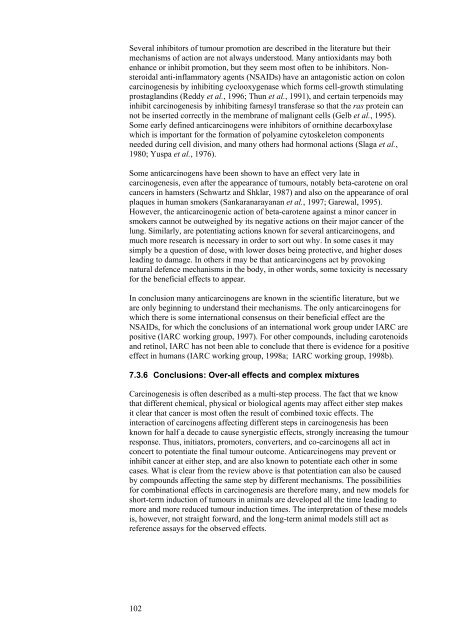Combined Actions and Interactions of Chemicals in Mixtures
Combined Actions and Interactions of Chemicals in Mixtures
Combined Actions and Interactions of Chemicals in Mixtures
Create successful ePaper yourself
Turn your PDF publications into a flip-book with our unique Google optimized e-Paper software.
Several <strong>in</strong>hibitors <strong>of</strong> tumour promotion are described <strong>in</strong> the literature but their<br />
mechanisms <strong>of</strong> action are not always understood. Many antioxidants may both<br />
enhance or <strong>in</strong>hibit promotion, but they seem most <strong>of</strong>ten to be <strong>in</strong>hibitors. Nonsteroidal<br />
anti-<strong>in</strong>flammatory agents (NSAIDs) have an antagonistic action on colon<br />
carc<strong>in</strong>ogenesis by <strong>in</strong>hibit<strong>in</strong>g cyclooxygenase which forms cell-growth stimulat<strong>in</strong>g<br />
prostagl<strong>and</strong><strong>in</strong>s (Reddy et al., 1996; Thun et al., 1991), <strong>and</strong> certa<strong>in</strong> terpenoids may<br />
<strong>in</strong>hibit carc<strong>in</strong>ogenesis by <strong>in</strong>hibit<strong>in</strong>g farnesyl transferase so that the ras prote<strong>in</strong> can<br />
not be <strong>in</strong>serted correctly <strong>in</strong> the membrane <strong>of</strong> malignant cells (Gelb et al., 1995).<br />
Some early def<strong>in</strong>ed anticarc<strong>in</strong>ogens were <strong>in</strong>hibitors <strong>of</strong> ornith<strong>in</strong>e decarboxylase<br />
which is important for the formation <strong>of</strong> polyam<strong>in</strong>e cytoskeleton components<br />
needed dur<strong>in</strong>g cell division, <strong>and</strong> many others had hormonal actions (Slaga et al.,<br />
1980; Yuspa et al., 1976).<br />
Some anticarc<strong>in</strong>ogens have been shown to have an effect very late <strong>in</strong><br />
carc<strong>in</strong>ogenesis, even after the appearance <strong>of</strong> tumours, notably beta-carotene on oral<br />
cancers <strong>in</strong> hamsters (Schwartz <strong>and</strong> Shklar, 1987) <strong>and</strong> also on the appearance <strong>of</strong> oral<br />
plaques <strong>in</strong> human smokers (Sankaranarayanan et al., 1997; Garewal, 1995).<br />
However, the anticarc<strong>in</strong>ogenic action <strong>of</strong> beta-carotene aga<strong>in</strong>st a m<strong>in</strong>or cancer <strong>in</strong><br />
smokers cannot be outweighed by its negative actions on their major cancer <strong>of</strong> the<br />
lung. Similarly, are potentiat<strong>in</strong>g actions known for several anticarc<strong>in</strong>ogens, <strong>and</strong><br />
much more research is necessary <strong>in</strong> order to sort out why. In some cases it may<br />
simply be a question <strong>of</strong> dose, with lower doses be<strong>in</strong>g protective, <strong>and</strong> higher doses<br />
lead<strong>in</strong>g to damage. In others it may be that anticarc<strong>in</strong>ogens act by provok<strong>in</strong>g<br />
natural defence mechanisms <strong>in</strong> the body, <strong>in</strong> other words, some toxicity is necessary<br />
for the beneficial effects to appear.<br />
In conclusion many anticarc<strong>in</strong>ogens are known <strong>in</strong> the scientific literature, but we<br />
are only beg<strong>in</strong>n<strong>in</strong>g to underst<strong>and</strong> their mechanisms. The only anticarc<strong>in</strong>ogens for<br />
which there is some <strong>in</strong>ternational consensus on their beneficial effect are the<br />
NSAIDs, for which the conclusions <strong>of</strong> an <strong>in</strong>ternational work group under IARC are<br />
positive (IARC work<strong>in</strong>g group, 1997). For other compounds, <strong>in</strong>clud<strong>in</strong>g carotenoids<br />
<strong>and</strong> ret<strong>in</strong>ol, IARC has not been able to conclude that there is evidence for a positive<br />
effect <strong>in</strong> humans (IARC work<strong>in</strong>g group, 1998a; IARC work<strong>in</strong>g group, 1998b).<br />
7.3.6 Conclusions: Over-all effects <strong>and</strong> complex mixtures<br />
Carc<strong>in</strong>ogenesis is <strong>of</strong>ten described as a multi-step process. The fact that we know<br />
that different chemical, physical or biological agents may affect either step makes<br />
it clear that cancer is most <strong>of</strong>ten the result <strong>of</strong> comb<strong>in</strong>ed toxic effects. The<br />
<strong>in</strong>teraction <strong>of</strong> carc<strong>in</strong>ogens affect<strong>in</strong>g different steps <strong>in</strong> carc<strong>in</strong>ogenesis has been<br />
known for half a decade to cause synergistic effects, strongly <strong>in</strong>creas<strong>in</strong>g the tumour<br />
response. Thus, <strong>in</strong>itiators, promoters, converters, <strong>and</strong> co-carc<strong>in</strong>ogens all act <strong>in</strong><br />
concert to potentiate the f<strong>in</strong>al tumour outcome. Anticarc<strong>in</strong>ogens may prevent or<br />
<strong>in</strong>hibit cancer at either step, <strong>and</strong> are also known to potentiate each other <strong>in</strong> some<br />
cases. What is clear from the review above is that potentiation can also be caused<br />
by compounds affect<strong>in</strong>g the same step by different mechanisms. The possibilities<br />
for comb<strong>in</strong>ational effects <strong>in</strong> carc<strong>in</strong>ogenesis are therefore many, <strong>and</strong> new models for<br />
short-term <strong>in</strong>duction <strong>of</strong> tumours <strong>in</strong> animals are developed all the time lead<strong>in</strong>g to<br />
more <strong>and</strong> more reduced tumour <strong>in</strong>duction times. The <strong>in</strong>terpretation <strong>of</strong> these models<br />
is, however, not straight forward, <strong>and</strong> the long-term animal models still act as<br />
reference assays for the observed effects.<br />
102

















